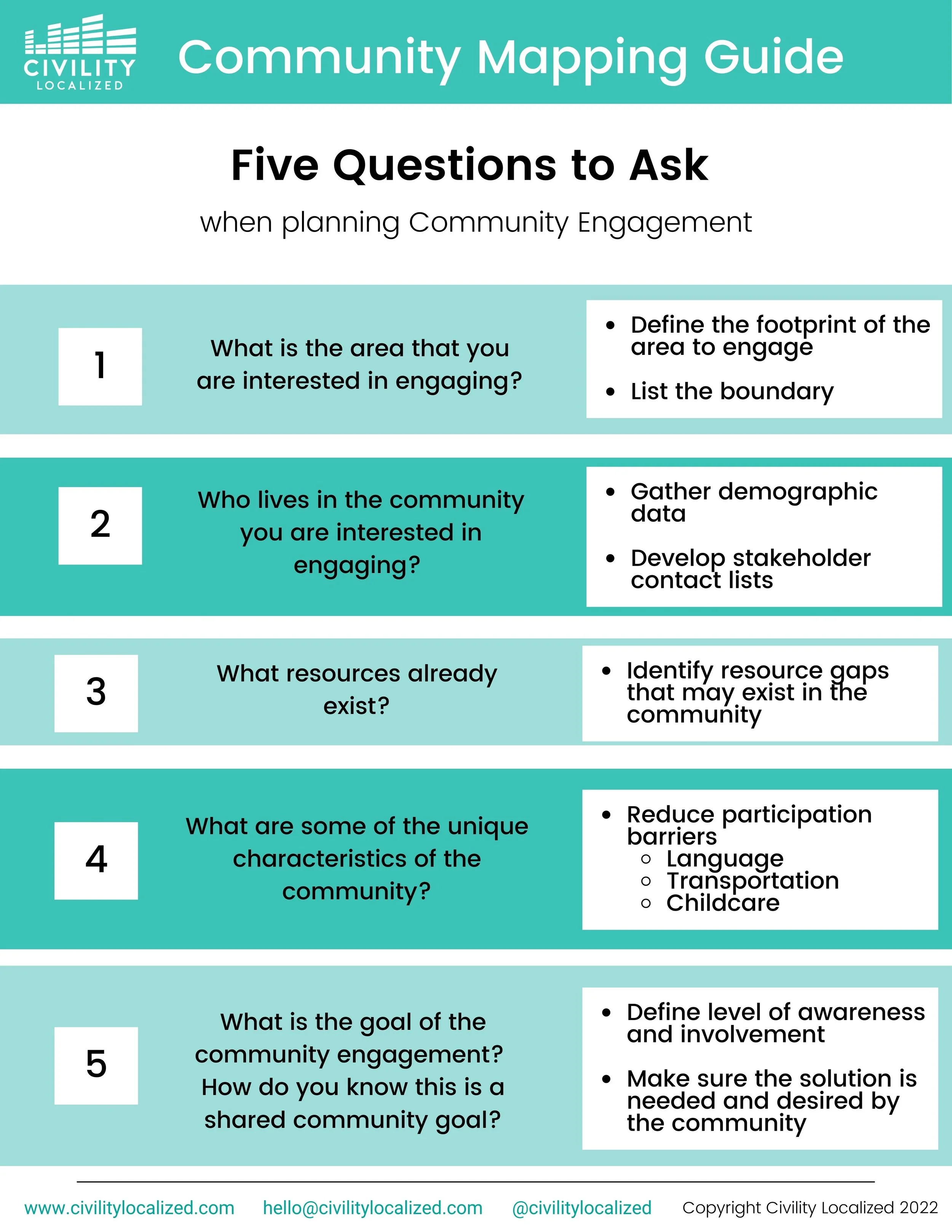Community Mapping
Five Questions to Ask When Planning Community Engagement
When planning a community engagement initiative, it is important to first map the community. This will help deepen understanding of the community's demographics, resources, and unique characteristics. It will also help identify barriers to participation that may impede engagement.
Here are five questions to ask when mapping a community:
What is the area that you are interested in engaging?
This could be a neighborhood, a city, or even a region. Once you know the area, you can start to define the footprint of the area to engage. This will help identify resources available in the community and the people who live there.
Who lives in the community you are interested in engaging?
Gather demographic data about the community, such as age, race, ethnicity, income, and education level. This information helps with understanding the needs of the community and tailoring engagement efforts accordingly. During this process, a stakeholder list should be developed.
What resources already exist?
Identify the resources that are already available in the community, such as schools, parks, libraries, and community centers. This information helps avoid duplicating efforts and allows engagement to build on existing resources. This also helps identify resource gaps that exist in the community.
What are some of the unique characteristics of the community?
Consider the community's history, culture, and values. This information illuminates each community's perspective and unique needs. This is where building trust begins. Once unique characteristics have been established, removing barriers to participation can begin. This may include such considerations as:
Language: In multilingual communities, engagement initiatives require interpretation and/or translation services.
Transportation: For communities lacking public transit, providing transportation to and from engagement events may be in order. In other instances, public transit vouchers, free parking, or parking validation go a long way to removing transportation barriers to participation.
Childcare: If the community has a large number of families with young children, providing childcare during engagement events can eliminate another barrier to participation. Possible solutions may include vouchers for existing care centers, or offering on-site childcare.
What is the goal of the community engagement? How do you know this is a shared community goal?
Define the goal of the community engagement and make sure that it is a shared goal. This helps ensure the engagement process is successful and meets the needs of those most impacted.
Civility Localized Community Mapping Guide, Copyright 2022
By mapping a community before engaging, we identify barriers to participation and increase the likelihood of a successful engagement process. A deeper understanding of community needs, resources, and unique characteristics improves the net impact of the process as well. As community engagement specialists, we must never lose sight of the fact that each community is made up of people, and those people deserve to see their community grow with dignity.
At Civility Localized, we pride ourselves on tailoring engagement efforts to the communities we work with. We aim to build trust with community members first and foremost.
Some of the ways we ensure the community mapping process is done thoroughly prior to engagement are as follows:
We use a variety of data sources, such as census data, demographic data, and community surveys.
We talk to community members and stakeholders to gain on-the-ground insight.
We are flexible and willing to adapt our plans based on the information gathered.
By following these strategies, we create a more accurate and comprehensive map of the communities we enter. This helps us engage them in meaningful ways, and helps us achieve the engagement goals of our government clients.
If your organization requires community mapping and engagement services, we are capable of providing comprehensive, specialized services. Please contact us via our website civilitylocalized.com to learn more.
We would be happy to answer any questions you have and help you develop a community engagement plan that is tailored to your needs. We look forward to hearing from you!

